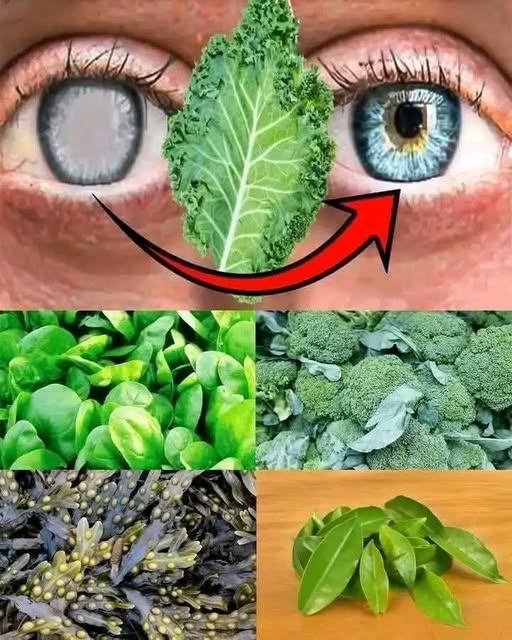Introduction:

Are you straining to read the small text on your screen or finding it harder to see clearly at night? You’re not alone. With the increasing time spent on digital devices, eye health has become a growing concern for millions worldwide. But what if nature already holds the answer? Imagine rejuvenating your vision, easing eye fatigue, and protecting against long-term damage—simply by adding a few miracle leaves to your daily routine.
In this article, we reveal 5 powerful leaves that support and even improve your eye health naturally. Backed by research, rich in antioxidants, and easily accessible, these green wonders can be a game-changer for your vision.
Let’s explore how these natural remedies can transform your eye health, provide lasting relief, and help you avoid costly treatments down the line.
Why Natural Leaves for Eye Health?
Before diving into our list, it’s essential to understand why natural leaves work. Vision health depends heavily on nutrients like Vitamin A, lutein, zeaxanthin, beta-carotene, and omega-3 fatty acids. Many green leaves contain these nutrients in abundance. Furthermore, they have anti-inflammatory, antioxidant, and detoxifying properties that protect delicate eye tissues from oxidative stress and inflammation.
According to the World Health Organization, over 2.2 billion people globally have a vision impairment or blindness, and at least 1 billion of these cases are preventable. This makes eye health not just important, but urgent.
The 5 Essential Leaves to Improve Eye Health Naturally
1. Moringa Leaves – The Vision Superfood
Moringa oleifera, often called the “miracle tree,” is loaded with vitamin A, C, and E—all essential for maintaining clear, healthy vision. Just 100 grams of fresh moringa leaves provide more than 250% of the daily requirement of Vitamin A.
Key Benefits:
- Protects against macular degeneration
- Reduces oxidative damage in retinal tissues
- Enhances night vision
- Rich in zeaxanthin and beta-carotene
How to Use:
Add fresh or dried moringa leaves to smoothies, soups, or take as a supplement. For best results, consume daily.
FAQ:
Q: Can moringa reverse existing eye damage?
A: While it may not reverse severe damage, consistent use can slow progression and prevent further deterioration.
2. Curry Leaves – Ancient Wisdom for Modern Eyes
Often used in Indian cooking, curry leaves are rich in vitamin A and B-carotene, which help prevent corneal dryness and clouding.
Key Benefits:
- Prevents cataracts and xerophthalmia (dry eye)
- Reduces free radicals in the eyes
- Supports retinal function
Did You Know?
One study in the Journal of Food Science found that curry leaves contain high levels of lutein, a critical nutrient for protecting the retina from UV and blue light exposure.
How to Use:
Chew 5–10 raw curry leaves every morning on an empty stomach, or brew them into a tea.
FAQ:
Q: Is curry leaf safe for daily use?
A: Absolutely. It’s non-toxic and beneficial when taken in moderation.
3. Spinach Leaves – The Lutein Powerhouse
Spinach is more than a salad staple—it’s a vision protector. Packed with lutein and zeaxanthin, these antioxidants filter harmful light and support long-term eye health.
Key Benefits:
- Prevents age-related macular degeneration (AMD)
- Shields eyes from sunlight damage
- Reduces eye strain from screen time
According to the American Optometric Association, consuming spinach three times a week can reduce the risk of AMD by up to 43%.
How to Use:
Include fresh spinach in your meals—raw in salads, sautéed, or in smoothies. Aim for a cup of spinach 3–5 times a week.
FAQ:
Q: Can children eat spinach for eye health?
A: Yes! It’s safe and highly recommended for developing eyes.
4. Basil Leaves – The Anti-Inflammatory Healer
Basil is not just for flavor—it’s an eye-friendly herb that’s loaded with Vitamin A, anti-inflammatory oils, and antioxidants that relieve tired, irritated eyes.
Key Benefits:
- Eases eye strain and inflammation
- Fights infections like conjunctivitis
- Supports tear production and moisture
Bonus: Basil leaves can be used topically for eye washes to soothe irritation.
How to Use:
Chew 5–6 fresh basil leaves daily or infuse in hot water for a calming herbal tea.
FAQ:
Q: Can basil help with dry eyes?
A: Yes. Its anti-inflammatory properties can ease dryness and promote tear production.
5. Coriander Leaves – Nature’s Detox for the Eyes
Fresh coriander leaves (also known as cilantro) are an eye tonic, flush with beta-carotene and iron, which helps prevent anemia-related vision issues.
Key Benefits:
- Reduces puffiness and inflammation
- Improves blood circulation around the eyes
- Fights toxins that damage vision
Coriander juice is a traditional Ayurvedic remedy for blurred vision and tired eyes.
How to Use:
Use coriander leaves in fresh juices, salads, or blended into green chutneys. For topical use, soak the leaves in water and apply as a cold eye compress.
FAQ:
Q: Is coriander suitable for sensitive eyes?
A: Yes. When used correctly, it is gentle and healing, both internally and externally.
Frequently Asked Questions (FAQs)
1. Can these leaves cure my eye condition completely?
These leaves are not substitutes for medical treatment. However, they are powerful preventative and supportive remedies that can significantly improve eye health, reduce symptoms, and enhance visual performance when used consistently.
2. How long before I see results?
While some people report improvements within a few weeks, long-term benefits typically show after 6–8 weeks of consistent use. Remember, natural remedies work gradually but effectively.
3. Can I combine all these leaves in one diet?
Yes! In fact, combining them increases the spectrum of phytonutrients and antioxidants, giving your eyes a comprehensive layer of protection.
4. Are there any side effects?
Generally, all these leaves are safe for most individuals. However, people with specific allergies or medical conditions should consult a healthcare provider before beginning a new herbal routine.
5. Can these be used alongside supplements?
Yes, they complement supplements well. In fact, using natural leaves can reduce your dependence on synthetic supplements over time.
Eye Health Tips That Go Beyond Diet
While consuming these five leaves is a game-changer, optimal eye health also depends on daily habits:
- Follow the 20-20-20 rule to reduce digital eye strain: every 20 minutes, look at something 20 feet away for 20 seconds.
- Wear UV-protection sunglasses to guard against sunlight damage.
- Get regular eye check-ups, especially if you’re over 40.
- Stay hydrated—dry eyes are often a sign of dehydration.
- Sleep well—your eyes need rest just as much as your body.
Conclusion: Nourish Your Eyes Naturally, Starting Today
In a world dominated by screens, stress, and pollution, your eyes are under more pressure than ever. But nature, as always, provides powerful solutions. The five leaves we’ve covered—moringa, curry, spinach, basil, and coriander—are not only easily accessible but also incredibly effective in supporting and preserving your vision.
By making these green allies part of your regular diet, you’re not just investing in clearer vision—you’re investing in a brighter, healthier future.
Don’t wait until you need glasses. Start today. Let your food be your medicine, and your leaves be your light.


